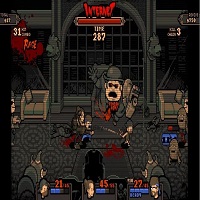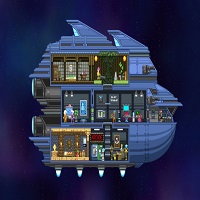
Review: Streets of Red – Devil’s Dare Deluxe(Switch eShop)
Back in the glory days of the arcade, beat ‘em up games represented some of the most fun and most challenging games that you could find. With a clear narrative and finite stages to follow, these games could be ‘beaten’, but it often took a monumental effort and a fistful of quarters. Secret Base wanted to revisit that experience in the modern age with Streets of Red – Devil’s Dare Deluxe, and it’s done a fantastic job of creating an arcade experience that both pays homage to the past while introducing new elements that bring it in line with current gameplay standards.
Streets of Red follows standard beat ‘em up gameplay, though there are a few modern infusions that breathe new life into the tried and true formula. You’ll still be spending much of your time mashing buttons, but there’s a little more method to it than basic attacks. Every character has three special attacks that are tuned to be effective in different situations, and these can be chained together with your standard attacks for some impressive and satisfying juggle combos.
The special attacks are governed by a constantly refilling skill gauge that’s used up in chunks depending on the attacks that you use, but these attacks form the backbone of your battle strategy. If you finish off an enemy with a special attack, they’ll drop more money then usual, and if you finish off three or more enemies with the same special attacks, it’ll trigger a Massacre and drop a health item in the field. All of this combines to make for a beat ‘em up experience that’s a little more cerebral than usual, as you’ll have to account for proper spacing, timing, and resource management while you’re cutting through the hordes.
There are four characters to choose from (and two more unlockables) which all manage to have varied movesets, yet still feel quite similar to each other, rather like how characters are designed in the Super Smash Bros. series. The button inputs are all the same and the specialized attacks generally all have the same effect (i.e. the neutral ‘B’ input is an AoE defensive attack for everybody), but the way that each character handles it is different. One character’s side-B attack may be a flamethrower while another’s is an aggressive shield charge, and it can be fun to do multiple playthroughs to try out different playstyles and to see how they link together. There can be moments where the button mashing can become a bit mindless, but Secret Base has done a fantastic job of creating a diverse combat system that favors experimentation.
Upon beating the boss of a stage, you’re greeted with a short menu screen that offers you the chance to upgrade your character, and this is where the rogue-lite elements come into play. The upgrades you can pick from are different every time, ranging from upgrading your special attacks to increasing the amount of money that you gain from enemy drops. These do a great job of adding a sense of progression and empowerment to your character, and if you feel that the upgrades make the game a little too easy, you can choose to forgo the buff in exchange for a cash reward.
That might not be a bad idea, either, as you will also need to spend money to revive your character if they’re killed, and the amount needed to revive goes up drastically each time. Should you be too poor to resurrect your character, the save is deleted and you restart from square one. These rogue-lite elements are a welcome inclusion, then, as they add diversity to each run and high-stakes to keep you on edge.
Technically, there are only four stages in Streets of Red, but it goes about expanding them in interesting ways. Stages are divided into levels that are referred to as ‘Nights’ and the number of nights per stage increases with each one you pick. So, the first stage you pick only has one night (and one boss), the next stage has two nights, and so on. Every stage has a total of four nights, but you’ll only see all four of those nights if you pick that stage last. This adds in a welcome amount of replay value, as each night has distinct environments and bosses to incentivize you to pick a different route on another playthrough.
Certain bosses are much tougher if the stage they show up in is picked later, so there’s an element of strategy to how you choose to navigate the game’s levels. There are also branching endings depending on the route you picked and your performance in the stages, and considering that it only takes maybe an hour to complete a run, this adds a healthy amount of incentive to dive back in and do a run differently.
Streets of Red also supports local four-player co-op, and this is where the game really begins to shine. Enemy numbers and difficulty scale up according to how many players you have at once, and everyone shares the same pool of money for revives and upgrades. It can be interesting to see how the various characters’ movesets link together, and setting up combos that require two or more people can be immensely satisfying once you master the timing. We’d highly recommend you give this one a go with a buddy; it’s fantastic fun when playing alone, but adding more players into the mix adds some variety and chaos to the experience that’s quite satisfying.
One minor complaint, however, is that it can be a little easy to lose your character in the madness on screen, and we took a few hits that maybe could’ve been avoided if it were easier to differentiate your character. Tapping the left shoulder button will temporarily shine a colored light on your character to help combat this, but it’s easy to forget about this when in the heat of battle.
From a presentation perspective, Streets of Red does a great job of crafting its own distinct charm, even if the visual style isn’t the greatest. The pixel art and animations are beautifully drawn and rendered, making for a lively experience, but the color palette is a little more muted than we’d prefer. Much of the visuals are characterised by a monochromatic brown, with red and blue being the only other colors. It’s an interesting design choice, and we can see what the developers were going for, it nonetheless falls a little flat. The soundtrack is similar, going for an 8-bit horror vibe, and while it provides a lovely and authentic sonic background to the action on screen, it can be rather forgettable.
We’d be remiss not to mention Streets of Red’s heavy reliance on pop culture references, which add plenty of humor and charm to the game’s stages. Whether you’re fighting Jason Voorhees wielding Cloud’s buster sword or a hybrid cross between the Demogorgon and Xenomorph, nearly every boss character is memorable and humorous in their design. The references show up in more subtle ways, too, such as how the stage intros mimic the act introductions from Sonic the Hedgehog, or how Shovel Knight appears in the background as a sculpture. There’s plenty of Easter eggs like these hidden around the game, and this is part of the reason for why it can be fun to try different routes and see what other nights have to offer.
If you happen to find the core game too easy, there’s an expert mode that doesn’t heal you between nights, and let you spend money to make bets before entering a night which will raise the strength of the enemies you’ll face. This does a good job of infusing the main mode with some higher intensity, and will no doubt challenge even the most seasoned gamer in the later stages. And if the main arcade mode is getting a little stale, there’s also an endless survival mode that tasks you with fending off more and more difficult waves of enemies in pursuit of a higher score. An in-game achievement system works across all of this, tasking you with playing the game in unconventional ways, and this adds some interesting wrinkles to challenge you in successive runs.
Source: http://www.nintendolife.com/reviews/switch-eshop/streets_of_red_-_devils_dare_deluxe
.




